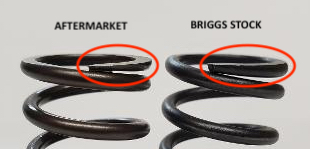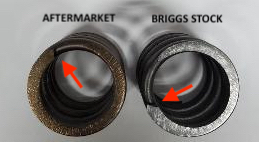|
What the heck is going on with Briggs 206 valve springs?
In the weeks leading up to Race 1, NHKA became aware of the presence of performance-enhancing aftermarket valve springs in some Briggs 206 engines. So we encouraged racers to have their engines inspected to confirm the exclusive use of stock parts, as required by the Briggs 206 Rules.
On May 3rd suspected aftermarket springs were found in an engine volunteered for inspection at the NHKA office. The springs were sent to Briggs and Stratton. On May 9th Briggs confirmed that the springs were not stock and that they were identical to known aftermarket springs.
Why wasn’t this resolved before the first race?
Unfortunately, with confirmation from Briggs coming only a few days before the first race, there simply was not sufficient time to address the issue club wide. Thus we were not surprised that post-race tech at Race 1 revealed non-compliant springs in two engines.
What does the Briggs 206 Rule Set say?
23. Valve Springs
a. Valve Springs are single coil stock, unaltered B&S part #26826. Must be identical in appearance to factory part and have 4.00 to 4.75 coils in stack.
b. Spring Wire Diameter: .103 to .107 inches
c. Valve spring length: .940 max inches Tech Tool A15 Inside diameter: Use .615 Class Z Go), .635” No-Go (Use .635” Class Z No-Go)
To paraphrase: Everyone must use B&S stock valve springs and nobody is allowed to mess with them.
Now what?
We need to eliminate these illegal springs from the NHKA’s 206 engine population as quickly as possible so we can get back to the box-stock fair racing you bought your 206 for in the first place!
How?
The key words in the rules for getting this mess behind us are “Must be identical in appearance to factory part”. The illegal springs can be easily identified just by popping off the valve cover and looking. That means the solution starts with you!
What am I looking for?
 The aftermarket springs look different from stock springs in two key ways. The first difference is color. As you can see in the photos, the aftermarket springs are bronze while the Briggs stock springs are black. The second visual tell is the shape of the “tail” or end of the spring where it is ground flat. As circled in the side-view photo, the tail of the aftermarket spring is significantly sharper/thinner than the stock spring. The aftermarket springs look different from stock springs in two key ways. The first difference is color. As you can see in the photos, the aftermarket springs are bronze while the Briggs stock springs are black. The second visual tell is the shape of the “tail” or end of the spring where it is ground flat. As circled in the side-view photo, the tail of the aftermarket spring is significantly sharper/thinner than the stock spring.
The arrows on the photo from above shows a third point of visual comparison. To see this the springs in question need to be uninstalled and compared directly with a known stock spring.  Stand them up next to each other making sure the bottom “tail” of both springs are in the same relative position (i.e., they are both in the 6 o’clock position in the photo.) Now compare the relative positions of the top “tails” and it is easy to see that the aftermarket spring has more coil. Stand them up next to each other making sure the bottom “tail” of both springs are in the same relative position (i.e., they are both in the 6 o’clock position in the photo.) Now compare the relative positions of the top “tails” and it is easy to see that the aftermarket spring has more coil.
What if my springs look bronze or my tails look too thin?
You should take your engine to your kart shop and ask that they make sure that your springs are the stock B&S part #26826.
I’ve read that the bronze color could be the result of the break in process and oils used by some engine builders.
That theory is entirely plausible. However, the engines found with the bronze springs showed ZERO discoloration on any other parts.
Doesn’t Briggs make go/no-go tools to check valve springs?
Yes, but the dimensions of the illegal springs (height, outside diameter, inside diameter and wire diameter) will pass inspection with Briggs tech tools.
Is it true that one of engines that failed post-race tech after Race 1 had passed tech at a race with a different series that uses the same rules?
It doesn’t matter. While the Briggs 206 Rule Set has enjoyed broad adoption, each race series that employs it is responsible for their own technical inspection procedures and decisions. The NHKA believes strongly in the spirit of fairness at the heart of the Briggs 206 Rule Set and strives to enforce them for the benefit of all our members.
Who is responsible for these springs?
We do not believe the use of these springs is deliberate cheating by any of our drivers, in fact most engine owners with them were genuinely surprised. Nonetheless, responsibility for the legality of a kart falls to the person racing it. So out of respect to your fellow racers and to avoid possible penalties, we again ask you to make sure your engine complies with the rules.
|